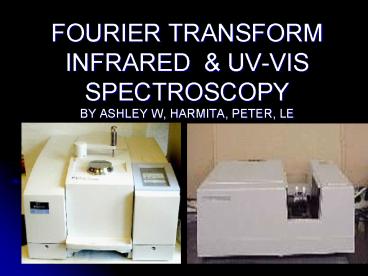FOURIER TRANSFORM INFRARED PowerPoint PPT Presentation
1 / 23
Title: FOURIER TRANSFORM INFRARED
1
FOURIER TRANSFORM INFRARED UV-VIS
SPECTROSCOPYBY ASHLEY W, HARMITA, PETER, LE
2
F T I R
- Fourier Transform Infrared spectroscopy
- WHAT IS IT ?
- It is an instrument that is commonly used to
identify functional groups of organic compounds
by measuring the vibration frequencies of
molecules when they are scanned with an infrared
light
www.chemistry.nmsu.edu
3
Vibrations
- Atoms in the molecule are subjected to number of
vibrations.
4
Theoretical principles
- In infrared spectroscopy wavelength is measured
in wave numbers which have the units cm-1 - IR radiation does not have enough energy to
induce electronic transitions as seen with UV.
Absorption of IR is restricted to compounds with
small energy differences in the possible
vibrational and rotational states. - For a molecule to absorb IR, the radiation must
interact with the electric field caused by
changing dipole moment
5
Calibration
www.internationalcrystal.net
www.chemistry.oregonstate.edu/courses/ch361-464/ch
362/irinstrs.htm - 9
- This device is precisely calibrated by using
polystyrene calibration film. - Size of peaks ? amount of material
6
Background Spectrum
- This background spectrum can be used to compare
with the sample measurement to determine
transmittance - Peaks in this region are characteristic of
specific kinds of bonds, thus can be used to
identify whether a specific functional group is
present.
7
Example of C-H(functional group) spectra
- Peaks in the region of (3000- 3100) cm-1
indicates that sp2 hybridized C-H bond are
present in the sample - And peaks in range of (2800-3000)cm-1 indicates
that sp3 hybridized C-H bond are present in a
sample
8
Acids 1650-1700cm-1 Esters 1740-1750cm-1
Aldehydes 1720-1750cm-1 Ketones
1720-1750 cm-1 Amides1650-1715 cm-1
9
FTIR Spectrum of Sample (98 N,N-Dimethylamphetami
ne Hydrochloride)
10
What information can FT-IR provide
- It can determine the amount of components in a
mixture - It can determine the quality or how consistent a
sample is - It can identify unknown materials
11
How FTIR works?
- Source Infrared energy is emitted from a glowing
black-body source. Ends at the Detector - Interferometer beam enters the interferometer
where the spectral encoding takes place - Interferogram signal then exits the
interferometer - Beamsplitter takes the incoming beam and divides
it into two optical beams - Sample beam enters the sample compartment where
it is transmitted through or reflected off of the
surface of the sample - Detector The beam finally passes to the detector
for final measurement - Computer measured signal is digitized and sent
to the computer where the Fourier transformation
takes place - Moving mirror in the interferometer is the only
moving part of the instrument - Fixed mirror
12
(No Transcript)
13
Is FT-IR Qualitative, Quantitative, or
Comparative?
- Qualitative
- -Because each different material is a unique
combination of atoms, no two compounds produce
the exact same infrared spectrum - -the size of the peaks in the spectrum is a
direct indication of the amount of material
present
- Quantitative and Comparative
- -Since it is sensitive, accurate, and has
software algorithms, the quantitative methods can
be developed and calibrated easily to perform
various analysis - -FT-IR is comparative due to the background
spectrum that is compared to the sample
14
Advantages/disadvantages
- Speed
- Sensitivity
- Mechanical simplicity
- Internally calibrated
- Destructive
- Too sensitive that it would detect the smallest
contaminant
15
Forensic Lab use
- A Forensic Scientist would use FT-IR to identify
chemicals in different types of samples - Paints
- Polymers
- Coatings
- Rugs
- Contaminants
- Explosive residues
16
UV-Vis Spectometer
17
UV-Vis
- Ultraviolet and visible spectrometers have been
in general use for the last 35 years - UV-Vis Spectrometers are used in many
applications for there simplicity, versatility,
speed, accurateness and cost effectiveness - There are often other methods available but
because of these qualities it is used - One of the most important and widely used
scientific instruments in the world
18
Uses of UV-Vis
- In 1941 Arnold Beckmans company National
Technical Laboratories introduced the first
spectrometer in a single case - These examples illustrate the impact of that
original instrument - the presence of vitamin A in foods using this
instrument. Vitamins have unique absorption
patterns in ultraviolet light - analyze the structure of penicillin so that the
molecule could then be synthetically produced in
large quantities during WWII - used in the analysis of crude oil for two
important substances benzene and toluene found
in TNT (WWII)
19
Qualitative
- Routinely used in the quantitative determination
of solutions of transitional metal ions and
highly conjugated organic compounds - Beer-Lambert law states that the absorbance of a
solution is directly proportional to the
solution's concentration. Thus UV - VIS can be
used to determine the concentration of a solution
A -log10(I/Io)
e.c.L A measured absorbance I
the transmitted intensity Io the
intensity of the incident light at a given
wavelength L the path length
through the sample ? molar
absorptivity constant C
concentration
20
Basic Components of UV-Vis
- Light Source
- Monochromator (wavelength detector)
- Cuvettes (sample)
- Detector
21
Basic Components of UV-Vis cont
- Light source (2 components)
- Source of UV radiation
- Deuterium excited under low pressure which
produces a constant UV spectrum, emits
wavelengths of 160 375nm - Visible light source
- Tungsten filament lamp emits in the spectrum of
350 2500nm - monochromator (5 components)
- entrance slit
- collimating lens
- dispersing device
- focusing lens
- exit slit
22
Calibrations
- To calibrate the UV-VIS spectrometer you place a
common solvent in one of the cuvettes and the
spectrometer will read the solvent and the sample
at the same time - Solvent for water soluble compounds is usually
water whilst the solvent for organic compounds is
usually ethanol
23
References
- http//www.wooster.edu/chemistry/is/brubaker/ir/ir
_works_modern.html - http//www.forumsci.co.il/HPLC/FTIR_page.html
- http//www.infrared-analysis.com/info1.htm
- http//teaching.shu.ac.uk/hwb/chemistry/tutorials/
molspec/uvvisab3.htm - http//icn2.umeche.maine.edu/genchemlabs/Spectra/S
pectra.htm - http//www.wfu.edu/chem/courses/organic/UV/index.h
tml - http//www.ptli.com/testlopedia/tests/UV-VIS-SPEC.
asp - www.thermonicolet.com
- http//teaching.shu.ac.uk/hwb/chemistry/tutorials/

